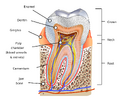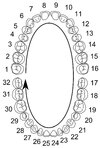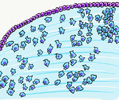The Science of Your Teeth
Disclaimer
This is not a guide for anything. This is just explaining the science behind your teeth. If you want to learn more about your teeth and how to take care of them, I suggest reading "THE ULTIMATE TEETHMAXXING GUIDE (MUST READ)" by pslgodduckz for the basics about oral health and the thread "ORTHO TREATMENTS AND SURGERIES" by sigma if you want to learn more about orthodontic treatment options. "Nothing But the Tooth: An Insider's Guide to Dental Health" by Teresa Yang is a very good book that essentially covers everything you'd need to know about dental health. Disclaimer
If you understand the science of how things are or how they work, it allows you to do looksmaxxing 'better'. I don't expect many people to read my long boring posts, but I'm writing them for people who are curious like me but don't want to dig through a million different websites to understand.
I also tried my best to share very complicated process in a very simple manner. With that being said, I don't know everything about the tooth. If you feel like I got something wrong, let me know and I'll see if a correction is in order.
What are your teeth exactly?
This probably sounds like a ridiculous question, and that's because it kind of is. However, we can't get anywhere if we don't go over the basics. So quit your complaining and buckle up. First, let's go over what your teeth are not. Your teeth are actually not bones. I know, this is actually surprising to a lot of people. They're apart of the digestive system, believe it or not. The reasoning for this is because they don't contain marrow, they don't regenerate like bone can, and because of the enamel that covers your teeth.
 First, let's go over what the enamel is. It's the hardest substance in the human body. Kind of makes sense when you consider that it's job is to protect your teeth from you smashing and crushing up food. 95%-96% of the enamel is made of minerals, namely hydroxyapatite, which is a crystalline calcium phosphate, and the rest is made out of water (4%-5%) and proteins (1%). They bond together to form small crystals.
First, let's go over what the enamel is. It's the hardest substance in the human body. Kind of makes sense when you consider that it's job is to protect your teeth from you smashing and crushing up food. 95%-96% of the enamel is made of minerals, namely hydroxyapatite, which is a crystalline calcium phosphate, and the rest is made out of water (4%-5%) and proteins (1%). They bond together to form small crystals. Second, the dentin. This is the part that rests underneath directly underneath the enamel. 45% of dentin is made of minerals, also hydroxyapatite, proteins (33%), and water (22%). Dentin is a bit more brittle and sensitive than the enamel, but is important to the tooth's overall structure.
Next is the cementum. This is a part of the tooth that is hardly spoken about. Mainly because it's not super interesting like the rest of the tooth is. It's the mineralized layer that covers the root of the tooth that sits inside the gum socket. That's it, really. It's mainly made of 45%-50% of hydroxylapatite, 50-55% of proteins and water. It's pretty soft compared to everything else up until this point.
The tooth pulp. This is where connective tissue, nerves, blood vessels, and odontoblasts lies within the innermost layer of a tooth. Without the pulp, a tooth becomes brittle and "dead". It loses it's sensitivity and the ability to combat/repair infections/cavities. It's important to maintaining the overall health of the tooth structure.
Normally these areas are simplified to sections. The crown refers to the visible portion above the gum, the root refers to the part of the tooth that is underneath the gum, and neck refers to the portion of the tooth that rests in between the crown and the root of the tooth.
We won't be discussing much about the anatomy of the jaw bone or the gums. Most of it's relevancy will be in how the teeth are formed.
What kind of teeth are there?
There are your baby teeth (AKA primary teeth) and then your adult teeth (AKA permanent teeth). 
Your baby teeth are normally replaced over time with your adult teeth. The age of which you lose your baby teeth depends on each individual. For the sake of this post, we'll mainly be referring to adult teeth.
So you have incisors, canines, premolars and then molars. Third molars are commonly called "wisdom teeth" (1, 16, 17, 32 on the graph). You can break these down even more, which you can see with the quote below:
wikipedia.org says:
Among permanent teeth, 16 are found in the maxilla and 16 in the mandible, for a total of 32. Permanent human teeth are numbered in a boustrophedonic sequence.
The maxillary teeth are the maxillary central incisors (teeth 8 and 9 in the diagram), maxillary lateral incisors (7 and 10), maxillary canines (6 and 11), maxillary first premolars (5 and 12), maxillary second premolars (4 and 13), maxillary first molars (3 and 14), maxillary second molars (2 and 15), and maxillary third molars (1 and 16). The mandibular teeth are the mandibular central incisors (24 and 25), mandibular lateral incisors (23 and 26), mandibular canines (22 and 27), mandibular first premolars (21 and 28), mandibular second premolars (20 and 29), mandibular first molars (19 and 30), mandibular second molars (18 and 31), and mandibular third molars (17 and 32).
How do your teeth form?
Enamel forms during tooth development within the jawbone. Well, I guess technically everything develops within the jawbone at first. Mature enamel can't regenerate once damaged, so that means once it's developed, it's developed. That's kind of it. However, before enamel forms, dentin production begins through a process called dentinogenesis. Interestingly, it's a 'lifelong process' in the sense that it also responds to decay or wear over time. Actually, the pulp and dentin go hand-in-hand when it comes to their development. The pulp helps create the dentin, and the dentin helps protect the pulp. The pulp does not regenerate and is normally why someone would get a root canal. The dentin and pulp also share a similar 'background' in their development. They both start to form when the dental papilla starts to form. (Explained more later)
Cementum is produced by a process called cementoblasts. These cells create the cementum in cycles, so it sometimes leaves a thing called hypercalcified lines behind. This just means there is an excessive deposition of calcium, leading to a higher than normal degree of mineralization. While cementum can repair slightly, it can't fully regenerate.
 In regards of the 'structure' in which a tooth is formed, it's first the Initiation stage -> Then the Bud stage -> Cap stage -> Bell stage -> and then finally the Crown stage.
In regards of the 'structure' in which a tooth is formed, it's first the Initiation stage -> Then the Bud stage -> Cap stage -> Bell stage -> and then finally the Crown stage. The initiation stage starts pretty early on microscopically. Actually, so early on you're still an embryo during this stage. This is when the dental lamina starts to form. This is not really the correct way of describing what's happening here, but for the sake of this post that's what I'm sticking with. The dental lamina essentially connects the developing tooth bud to the epithelial layer (a protective barrier of sorts) of the mouth.
The bud stage also starts on pretty early on. You're a fetus at this point. At around 8 weeks in the fetus, small clusters of epithelial cells (tooth buds) form along the dental lamina (that was formed previously)- one for each future primary tooth. These buds are surrounded by a 'basement membrane', while the underlying ectomesenchymal cells (cells for vertebrate development) begin gathering beneath them in a somewhat organized way.
The cap stage is when the tooth bud starts taking shape. Some cells cluster together to form the dental papilla - which will become the tooth's inner parts, the dentin and pulp. The growing tooth bud wraps around this cluster like a cap (hence it's name), now called the enamel organ (the process in which the enamel starts to form). Another layer of cells (called the dental sac) forms around everything.
The bell stage/crown stage is when the tooth gets its final 'shape' and 'specialized' cells form. The enamel organ becomes bell-shaped (hence it's name, again) with four key layers: the inner enamel epithelium (makes enamel), the stratum intermedium (supports enamel formation), the stellate reticulum ('cushions' the growing tooth) and the outer enamel epithelium (protective outer layer). Technically, they're two different stages, but they form so closely together that the crown stage is also referred to the 'late bell stage'.
That's all I can think of for now. If you have any questions or feel like I missed something important, let me know.

